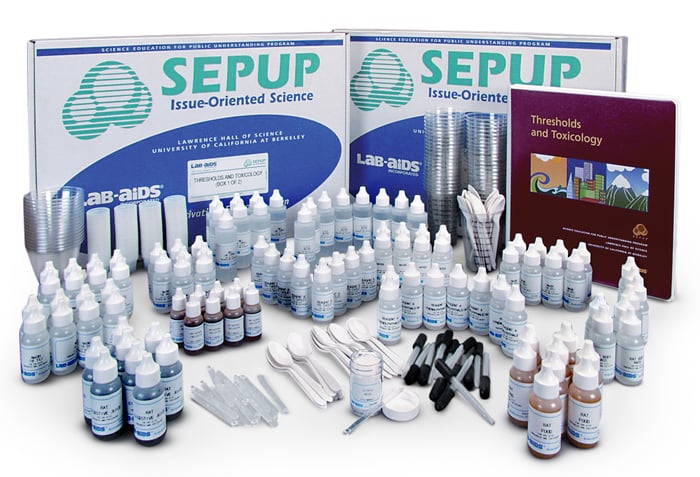Thresholds and Toxicology (Developed by SEPUP)

In this module, students examine the historical development of the regulation process, and consider a modern day example using “lily juice,” a hypothetical herbal remedy promoted to increase intelligence. Simulated rat toxicity testing provides data that can be analyzed to decide whether the product should be allowed. Acute and chronic health effects are considered in the final decision.
This module includes a Teacher's Guide
Module requires 16 SEPUP trays (not included)
Accommodates five classes, each with 8 groups of four students
More Info
1. Thresholds, Concentration, and Trade-offs
Students perform a taste test to determine the concentration at which a citric acid solution tastes different from water and the concentration at which the solution tastes unpleasant.
2. Chemical Indicators and Chemical Concentration
Students serially dilute a 1,000 ppm solution of citric acid and test a range of concentrations with universal indicator. They compare the ability of indicator to detect low concentrations with that of taste buds. The need to test products for consumer safety is introduced.
3. Regulating the Safety, Effectiveness, and Advertising of Medicines
The reading provides a brief look at past and present U.S. regulations regarding testing for medicines and at advertisement strategies. The reading provides a context for the simulated toxicology testing done in Activity 4 and information relevant to the design of the package for the marketing of “lily juice” in Activity 9 and to the regulations for food supplements considered in Activity 10.
4. Simulated Toxicology Tests
Students use a chemical simulation to determine the acute effects of “lily juice,” a fictitious unknown substance, on lab rats. Students find that at very low doses “lily juice” has no effect, at doses above the positive threshold dose (PTD) it has a positive effect, but at doses above the negative threshold dose (NTD) it has a negative effect.
5. Using Chemical Reagents to Identify Unknown Chemicals
Students use reagents to compare and differentiate one solution from another. Results from reagent testing indicate that “lily juice” behaves similarly to a solution of NaOH, but not identically, indicating that “lily juice” maybe a solution of NaOH that has a different concentration from the solution tested.
6. Obtaining Quantitative Data Using Titrations
Students titrate solutions of known NaOH concentration and of “lily juice,” a solution of unknown NaOH concentration. They plot their results on a graph, prepare a line of best fit, and use the graph to estimate the concentration of NaOH in “lily juice.”
7. Analyzing Long-Term Effects
Students continue their investigation of the effects of “lily juice” by graphing data from a long-term study of rats that were given low doses of “lily juice” throughout their lives.
8. Investigating the Effects of Body Mass
Students design and conduct another simulated toxicology investigation to determine if “rat body weight” has any effect on the PTD and NTD of “lily juice.”
9. Determining Safe and Appropriate Product Use
Students prioritize the information gleaned from all the previous investigations to prepare a package for “lily juice” that clearly indicates its appropriate and safe use.
10. Evaluating Regulatory Issues
Students apply what they have learned to the issue of how much, if any, regulation there should be for herbal remedies. Students consider both the personal perspective – the individual’s right to choose – and the public perspective – the government’s responsibility to ensure the safety of its residents.
Scientific Concepts
- Humans vary in their responses to different stimuli. The threshold level of a stimulus is the lowest level that provokes a response.
- The concentration of a dissolved substance can be expressed in parts per million (ppm) and parts per billion (ppb). Chemical indicators can be used to estimate the concentration of dissolved substances.
- Animal testing is often used to help establish positive (therapeutic) and negative (toxic) threshold levels. Both chronic and acute effects must be considered when determining the safety and effectiveness of a product.
- Gathering relevant evidence is essential for thoughtful inquiry and good decision making.
- Making decisions about complex issues often involves trade-offs and evaluating issues requires an analysis of both risks (costs) and benefits.
Guides & Student Sheets
Our kits and modules provide you with everything you need so you can open, review, and teach the material confidently the next day.
- Comprehensive Teacher Guide with background information, detailed instruction, example data and answers
- Student Sheets with age appropriate background information, full procedure(s), and analysis items
- Materials necessary for the investigation (beyond common classroom items)
- Safety Data Sheets
Module Components
- 1 Teacher’s Guide with reproducible masters for Student Sheets
- 250 Tasting cups
- 80 240 mL graduated cups
- 40 Plastic spoons
- 16 LAB-AIDS® measuring/mixing spatulas
- 16 9 x 12" plastic bags
- 16 9 oz plastic cups
- 16 Droppers
- 8 Drop control bottles of Universal Indicator solution
- 8 Drop control bottles of simulated Rat Food solution
- 8 Drop control bottles of simulated Rat Body Mass solution
- 8 Drop control bottles of simulated Rat Digestive Juice solution
- 8 Drop control bottles of simulated Lily Juice solution
- 8 Drop control bottles of Na2CO3 solution (Sodium carbonate), 5%
- 8 Drop control bottles of NaOH solution (Sodium hydroxide), 0.1%
- 8 Drop control bottles of Reagent A solution (phenolphthalein)
- 8 Drop control bottles of Reagent B solution, (5% Calcium chloride)
- 8 Drop control bottles of NaOH solution (Sodium hydroxide), 0.4%
- 8 Drop control bottles of NaOH solution (Sodium hydroxide), 0.6%
- 8 Drop control bottles of HCl solution (Hydrochloric Acid), 0.125%
- 8 Drop control bottles of "Water", empty
- 1 Vial of Citric Acid
- 1 MSDS (Material Safety Data Sheet) set
- THIS MODULE REQUIRES 16 SEPUP TRAYS
